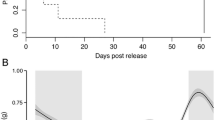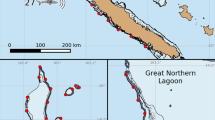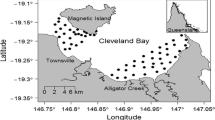Abstract
The Hawaiian stingray, Dasyatis lata, is a common benthic elasmobranch in nearshore Hawaiian waters. Acoustic telemetry was used to track the movements of seven rays in Kaneohe Bay, Oahu, Hawaii. Rays were tracked continuously over 31–74 h periods. Geographical movements were analyzed to determine space utilization and rate of movement. Rays were found to utilize significantly larger activity spaces at night (0.83±0.70 km2) (mean±SD) than during the day (0.12±0.15 km2). Mean total activity space for rays tracked was 1.32±0.75 km2. Rates of movement were also significantly higher at night (0.34±0.30 km h-1) than during the day (0.15±0.22 km h-1). Average straight-line swimming speed was 0.64±0.16 km h-1, with a maximum observed swimming speed of 1.9 km h-1. Tidal stage had no effect on rate of movement. Comparison with previously published data on juvenile scalloped hammerhead sharks, Sphyrna lewini, in Kaneohe Bay revealed a high degree of overlap in habitat use and time of activity, suggesting possible ecological interactions between these two species.





Similar content being viewed by others
References
Bray R, Hixon M (1978) Night-shocker: predatory behavior of the Pacific electric ray (Torpedo californica). Science 200:333–334
Bush A, Holland K (2002) Food limitation in a nursery area: estimates of daily ration in juvenile scalloped hammerheads, Sphyrna lewini (Griffith and Smith 1834) in Kane'ohe Bay, O'ahu, Hawai'i. J Exp Mar Biol Ecol 278:157–178
Capape C, Zaouali J (1992) Le regime alimentaire de la pastengue marbree, Dasyatis marmorata (Pisces, Dasyatidae), des eaux Tunisiennes. Vie Milieu 42:269–276
Clarke T (1971) The ecology of the scalloped hammerhead shark, Sphyrna lewini, in Hawaii. Pac Sci 25:133–144
Francis M (1998) New Zealand shark fisheries: development, size and management. Mar Freshw Res 49:579–591
Gilliam D, Sullivan K (1993) Diet and feeding habits of the southern stingray, Dasyatis americana, in the central Bahamas. Bull Mar Sci 52:1007–1013
Gray A, Mulligan T, Hannah R (1997) Food habits, occurrence, and population structure of the bat ray, Myliobatis californica, in Humboldt Bay, California. Environ Biol Fish 49:227–238
Gruber S, Nelson D, Morrissey J (1988) Patterns of activity and space utilization of lemon sharks, Negaprion brevirostris, in a shallow Bahamian lagoon. Bull Mar Sci 43:61–76
Holland K, Lowe C, Peterson J, Gill A (1992) Tracking coastal sharks with small boats: hammerhead shark pups as a case study. Aust J Mar Freshw Res 43:61–66
Holland K, Wetherbee B, Peterson J, Lowe C (1993) Movements and distribution of hammerhead shark pups on their natal grounds. Copeia 1993:495–502
Hooge P, Eichenlaub E (1997) Animal movements extension to Arcview. Alaska Biological Center, US Geological Survey, Anchorage, Alaska
Karl S, Obrebski S (1976) The feeding biology of the bat ray, Myliobatis californica, in Tomales Bay, California. In: Simenstad CA, Lipovski SJ (eds) Fish food habit studies. Washington Sea Grant, Seattle, pp 181–186
Lewis T (1982) The reproductive anatomy, seasonal cycles, and development of the Atlantic stingray, Dasyatis sabina (LeSueur) (Pisces, Dasyatidae). PhD Dissertation, Florida State University, Tallahassee, Fla.
Lowe C (2001) Metabolic rates of juvenile scalloped hammerhead sharks (Sphyrna lewini). Mar Biol 139:447–453
Lowe C (2002) Bioenergetics of free-ranging juvenile scalloped hammerhead sharks (Sphyrna lewini) in Kane'ohe Bay, O'ahu, HI. J Exp Mar Biol Ecol 278:141–156
Matern SA, Cech JJ, Jr, Hopkins TE (2000) Diel movements of bat rays, Myliobatis californica in Tomales Bay, California: evidence for behavioral thermoregulation? Environ Biol Fish 58:173–182
Nelson D, Johnson R (1970) Diel activity rhythms in the nocturnal bottom-dwelling sharks, Heterodontus francisci and Cephaloscyllium ventriosum. Copeia 1970:732–739
Nelson D, Johnson R (1980) Behavior of the reef sharks of Rangiroa, French Polynesia. Natl Geogr Soc Res Rep 12:479–499
Nishida K, Nakaya K (1990) Taxonomy of the genus Dasyatis (Elasmobranchii, Dasyatidae) from the north Pacific. US Natl Mar Fish Serv NOAA Tech Rep NMFS 90:327–346
Orth R (1975) Destruction of eelgrass, Zostera marina, by the cownose ray, Rhinoptera bonasus, in the Chesapeake Bay. Chesapeake Sci 16:205–208
Schmid T (1988) Age, growth, and movement patterns of the Atlantic stingray, Dasyatis sabina, in a Florida coastal lagoon. MS Thesis, University of Central Florida, Orlando, Fla.
Schwartz F, Dahlberg M (1978) Biology and ecology of the Atlantic stingray, Dasyatis sabina. Contrib Mar Sci Univ Tex 16:71–74
Seaman D, Powell R (1996) An evaluation of the accuracy of kernel density estimators for home range analysis. Ecology 77:2075–2085
Silliman W, Gruber S (1999) Behavioral biology of the spotted eagle ray, Aetobatus narinari. Bahamas J Sci 7:13–20
Sisneros J, Tricas T (2000) Androgen-induced changes in the response dynamics of ampullary electrosensory primary afferent neurons. J Neurosci 20:8586–8595
Smith C, Kukert H (1996) Macrobenthic community structure, secondary production, and rates of bioturbation and sedimentation at the Kaneohe Bay lagoon floor. Pac Sci 50:211–229
Smith J, Merriner J (1985) Food habits and feeding behavior of the cownose ray, Rhinoptera bonasus, in lower Chesapeake Bay. Estuaries 8:305–310
Smith S, Kimmerer W, Laws E, Brock R, Walsh T (1981) Kaneohe Bay sewage diversion experiment: Perspectives on ecosystem responses to nutritional perturbation. Pac Sci 35:279–395
Snelson F Jr, Williams S (1981) Notes on the occurrence, distribution, and biology of elasmobranch fishes in the Indian River lagoon system, Florida. Estuaries 4:110–120
Snelson F Jr, Williams-Hooper S, Schmid T (1988) Reproduction and ecology of the Atlantic stingray, Dasyatis sabina, in Florida coastal lagoons. Copeia 1988:729–739
Standora E, Nelson D (1977) A telemetric study of the behavior of free-swimming Pacific angel sharks, Squatina californica. Bull S C Acad Sci 76:193–201
Struhsaker P (1969) Observations on the biology and distribution of the thorny stingray, Dasyatis centroura (Pisces: Dasyatidae). Bull Mar Sci 19:456–481
Thorson T (1983) Observations on the morphology, ecology, and life history of the euryhaline stingray, Dasyatis guttata (Bloch and Schneider) 1801. Acta Biol Venez 11:95–125
Thrush S, Pridmore R, Hewitt J, Cummings V (1991) Impact of ray feeding disturbances on sandflat macrobenthos: do communities dominated by polychaetes or shellfish respond differently? Mar Ecol Prog Ser 69:245–252
Worton B (1989) Kernel methods for estimating the utilization distribution in home-range studies. Ecology 70:164–168
Acknowledgements
This study was supported by the Pauley Foundation's Summer Program in Elasmobranch Biology, the Hawaii Institute of Marine Biology, and California State University, Long Beach. We thank A. Castro, E. Rechisky, Y. Papastamatiou, M. Marcotte, J. Henly, T. Lisney, L. Haines, J. New, E. Heist, K. Duncan, T. Fitzgerald, A. Jaffe, I. Ohta, A. Schrey, L. Tyler, J. Mello, B. Frentzel-Beyme, S. Kajiura, and A. Bush for their assistance tracking. This project was approved by the University of Hawaii's Animal Care and Welfare Board.
Author information
Authors and Affiliations
Corresponding author
Additional information
Communicated by: P.W. Sammarco, Chauvin
Rights and permissions
About this article
Cite this article
Cartamil, D.P., Vaudo, J.J., Lowe, C.G. et al. Diel movement patterns of the Hawaiian stingray, Dasyatis lata: implications for ecological interactions between sympatric elasmobranch species. Marine Biology 142, 841–847 (2003). https://doi.org/10.1007/s00227-003-1014-y
Received:
Accepted:
Published:
Issue Date:
DOI: https://doi.org/10.1007/s00227-003-1014-y




